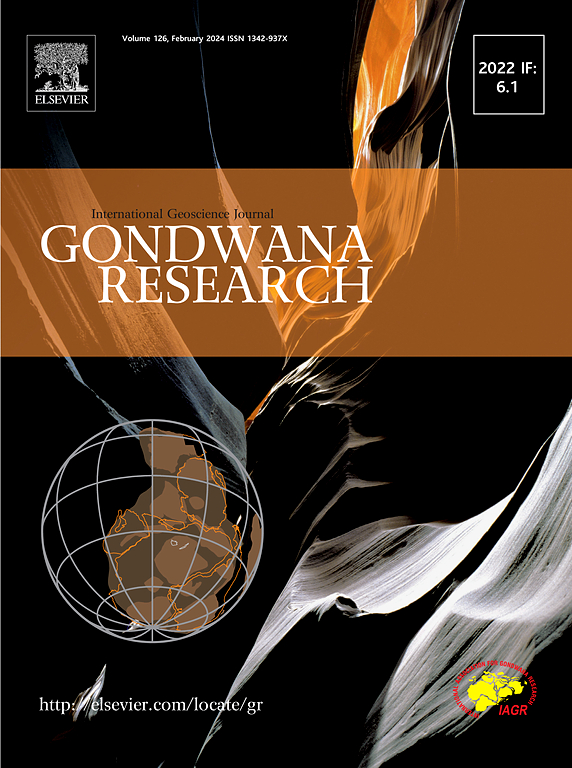Proterozoic crustal evolution of the eastern Vindhyan basin, central India: Constraints from geophysical and geochronological data
IF 7.2
1区 地球科学
Q1 GEOSCIENCES, MULTIDISCIPLINARY
引用次数: 0
Abstract
The Vindhyan basin is one of the major Proterozoic basins in the Indian shield bounded by Central Indian Tectonic Zone (CITZ) in the south and Bundelkhand craton in the north having thick sedimentary succession. Interaction of basin with CITZ and its imprints on regional crustal structure is important to understand its evolution. In this study, a detailed interpretation of gravity and aeromagnetic anomaly maps with constraints from multi-channel seismic data is carried out in the Son valley part of the Vindhyan basin to identify its structural links with the surrounding tectonic domains. The 3-D gravity inversion along with 2-D gravity and magnetic modelling helped to delineate the crustal architecture and Moho geometry which reveal that the Moho below the basin varies between 38–46 km with the deepest Moho in southern part along its boundary. The crustal models in the study area further reveal i) higher density and magnetization for lower Vindhyan sediments because of intrusive rocks/ volcano clastic sediments, ii) the eastern part of basin is devoid of crustal underplating iii) basement high, complex rift tectonics and basin tilting in Damoh region, iv) undulating crustal layers intervened by deep crustal faults in the southern part of the basin and the CITZ region, and v) the Bundelkhand Tectonic Zone and Madaura Shear Zone in the craton are characterized by deep crustal faults. In this paper, we propose a geodynamic evolutionary model of the Vindhyan basin which reveals opening of the basin subsequent to the formation of CITZ during ∼ 2000–2200 Ma. The basin sediments were deposited in multiple stages during 1700–1000 Ma followed by the basin closure during 1000–750 Ma. Hence, it is inferred that the post tectonic activity of the CITZ affected the Son Narmada fault zone and facilitated the opening of Vindhyan basin during the Paleoproterozoic period.

印度中部Vindhyan盆地东部元古代地壳演化:来自地球物理和地质年代学资料的约束
温德扬盆地是印度盾构中主要的元古代盆地之一,南接印度中部构造带,北接本德尔坎德克拉通,具有较厚的沉积演替。盆地与CITZ的相互作用及其在区域地壳结构上的印记对了解其演化具有重要意义。本文在多道地震资料约束下,详细解释了Vindhyan盆地Son valley部分的重磁异常图,以确定其与周围构造域的构造联系。三维重力反演和二维重磁模拟有助于圈定地壳结构和莫霍面几何形状,揭示了盆地下方的莫霍面在38 ~ 46 km之间变化,最深的莫霍面位于盆地南部边界。研究区地壳模型进一步揭示:1)侵入岩/火山碎屑沉积使下温德扬期沉积物密度和磁化强度较高;2)盆地东部缺乏地壳底带;3)达末地区基底隆起、复杂裂谷构造和盆地倾斜;4)盆地南部和CITZ地区受深地壳断裂干预的起伏地壳层。克拉通的本德尔汉德构造带和马多拉剪切带以地壳深部断裂为特征。在本文中,我们提出了一个Vindhyan盆地的地球动力学演化模型,该模型揭示了在CITZ形成之后的2000-2200 Ma期间盆地的开放。盆地沉积物在1700 ~ 1000 Ma期间分多个阶段沉积,随后在1000 ~ 750 Ma期间盆地闭合。据此推断,古元古代,中关带的后构造活动影响了Son Narmada断裂带,促进了Vindhyan盆地的张开。
本文章由计算机程序翻译,如有差异,请以英文原文为准。
求助全文
约1分钟内获得全文
求助全文
来源期刊

Gondwana Research
地学-地球科学综合
CiteScore
12.90
自引率
6.60%
发文量
298
审稿时长
65 days
期刊介绍:
Gondwana Research (GR) is an International Journal aimed to promote high quality research publications on all topics related to solid Earth, particularly with reference to the origin and evolution of continents, continental assemblies and their resources. GR is an "all earth science" journal with no restrictions on geological time, terrane or theme and covers a wide spectrum of topics in geosciences such as geology, geomorphology, palaeontology, structure, petrology, geochemistry, stable isotopes, geochronology, economic geology, exploration geology, engineering geology, geophysics, and environmental geology among other themes, and provides an appropriate forum to integrate studies from different disciplines and different terrains. In addition to regular articles and thematic issues, the journal invites high profile state-of-the-art reviews on thrust area topics for its column, ''GR FOCUS''. Focus articles include short biographies and photographs of the authors. Short articles (within ten printed pages) for rapid publication reporting important discoveries or innovative models of global interest will be considered under the category ''GR LETTERS''.
 求助内容:
求助内容: 应助结果提醒方式:
应助结果提醒方式:


